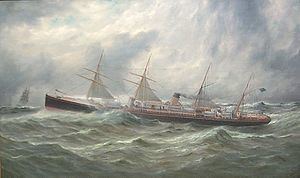Name SS Adriatic Completed 31 March 1872 Length 133 m Builder Harland and Wolff | Yard number 77 Launched 17 October 1871 Beam 12 m | |
 | ||
Maiden voyage Liverpool–New York, April 1872 | ||
SS Adriatic was the first of two White Star Line ocean liners to carry the name Adriatic. The White Star Line's first four steamships, the (Oceanic (I), Atlantic, Baltic, and the Republic) met with great success in the trans-Atlantic market, and the line decided to build two more. The first of these was the SS Adriatic, which was built by Harland and Wolff and launched on 17 October 1871; the second was the Celtic.
History
During the remainder of 1871 and the early part of 1872, Adriatic was fitted out. As a part of this process, a technology new to that era was tried on the ship. Up to this point, ships' cabins had been lit by oil lamps, but the builders decided to try new gas lamps on Adriatic. A machine was added to the engine room to produce gas from coal, the first ship in the world to have such a system, but problems with gas leaks meant it had to be removed before the ship went into service.
Adriatic left on her maiden voyage on 11 April 1872, sailing from Liverpool to New York, under Captain Sir Digby Murray, who had captained the maiden voyage of the White Star's first ship, Oceanic the year before. Adriatic was similar in configuration to the earlier Oceanic-class ships, with a single funnel and four masts, with the highest towering to 150 ft (46 m), and the first three square-rigged. Her hull was painted black in typical White Star fashion, and accommodated two classes, First and Steerage. As the largest of the six White Star Line ships, Adriatic received the designation as the Line's flagship, a title she held until the larger Britannic came on line in 1874.
A month later, during a subsequent Atlantic crossing to New York, Adriatic maintained an average speed of 14.52 knots and won the Blue Riband away from the Cunard Line's Scotia, which she held since 1866.
Adriatic was involved in several accidents. The first occurred in October 1874, when she collided with the Cunard Line's Parthia while sailing parallel. There was little damage to either ship. In March, 1875, Adriatic rammed the American ship Columbus in the Crosby Channel at Liverpool; Columbus was sunk and her captain's child was drowned, but the other six people on board were rescued by a passing ship.
In December of the same year, in St. Georges Channel, Adriatic ran down and sank the sailing vessel Harvest Queen in an accident that resulted in the loss of all life aboard Harvest Queen. Harvest Queen sank so quickly that the crew of Adriatic could not identify what ship they had hit, and only a records search later showed who the victim had been. On 19 July 1878, Adriatic hit the brig G. A. Pike off of South Wales, killing five crew on board Pike. Blame was fixed on Adriatic for excessive speed.
In 1883, Adriatic carried copper wire bars from New York to Liverpool that were subsequently used to create the first ever London Metal Exchange warrant issued by the company Henry Bath & Son Ltd.
In 1884, Adriatic underwent a refit, during which accommodations for 50 second class passengers were added. In 1897, she was deemed too old for regular trans-Atlantic service, and was laid up as a reserve ship for the Line, at Birkenhead. When RMS Oceanic entered service in 1899, Adriatic was sold for scrap, arriving in Preston on 12 February.
